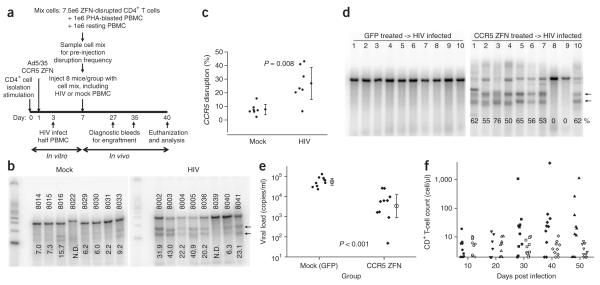Figure 4.
Reduction in viremia and selection for CCR5 ZFN-modified CD4+ T cells in the presence of HIV-1 challenge in vivo. (a) Experimental outline for adoptive transfer of modified CD4+ T cells and in vivo HIV-1 challenge in NOG mice. CCR5 ZFN-transduced CD4+ T-cell population pre-mix (day 3); CCR5 disruption level, 33%. Injected mixed samples baseline CCR5 disruption level 15% in control (mock infected) and 14% in HIV-infected group (day 7). (b) Level of ZFN-disrupted CCR5 alleles in CD4+ T cells isolated on day 40 from spleens of control or HIV-infected mice. Percent disruption indicated at base of each lane. One mouse from each group (HIV-infected mouse no. 8039 and control mouse no. 8022) excluded for later analysis due to inadequate CD4+ T-cell DNA recovery and purification. N.D., not determined. (c) Plot of in vivo disruption frequencies in spleens on day 40. Results for each group (n = 7) averaged and analyzed using an unpaired t-test with mean ± 95% confidence intervals indicated. (d–f) In an independent experiment, mice were engrafted with CCR5 ZFN-transduced CD4+ T cells (51% disruption) or GFP-transduced cells (mock) and followed for 50 d post HIV-1 infection. Enrichment for CCR5-disrupted CD4+ T cells in peripheral blood on day 50 post infection (Surveyor assay); lower migrating products (arrows) are a direct measure of ZFN-mediated gene disruption (d). Plasma viremia in mice day 10 post infection. HIV-1 viral RNA (copies/ml) is plotted for the individual mice; the mean ± 95% confidence interval is shown (e). The CCR5 ZFN-treated mice had a significantly lower viral load (P < 0.001; Mann Whitney test). Engraftment of CD4+ T cells in peripheral blood from days 10 to 50 post infection. The CD4+ T-cell counts (Trucount assay) for the mice engrafted with CCR5 ZFN-(solid symbols) and GFP-modified cells (open symbols) are plotted (f). Mice engrafted with CCR5 ZFN-treated cells had higher CD4+ T-cell counts on days 30–50 post infection (P = 0.04).

